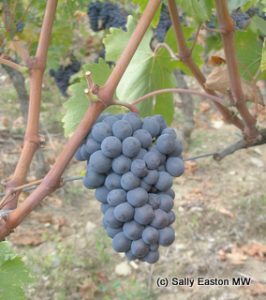Under the influence of Carlo Ferrini

Carlo Ferrini
Last month in London, heralded consultant winemaker, the Italian Carlo Ferrini, presented some of the wines he’s influenced, and outlined his philosophy.
Ferrini works for about 30 producers, unusually all of them being in his home country of Italy. He is a Tuscan man by heritage and mien, and he made his first vintage in 1979, subsequently heading up the technical department of the Consorzio del Chianti Classico. He was also a leading light of the Chianti Classico 2000 project, which researched sangiovese to find better quality clones.
He has stretched his consulting expertise across the thousand miles of Italy’s wine regions from Sicily in the south, to, most recently, Piedmont in the north.
This is a man who says his role as consultant is “to give each producer a proper character to the wines of the estate.” He emphasises the ‘whole property’ aspect of his consulting, saying vineyard is inseparable from winemaking. He said “I try to manage the vineyard, the foliage, the yields, and bring together two concepts of paramount importance: one, the care in the vineyard, the second one in the cellar, with open fermentation vats, longish fermentation with punching down, up to 20 days.”
He believes punching down the cap is gentler than pumping over, and he’s keen to avoid bitterness in the tannins and fruit, which he does by avoiding stressing the grapes in the cellar.
Ferrini’s also keen to distance himself from formulaic winemaking, a critique often levelled at consultant winemakers. He said “though I’m in favour of punching down the cap rather than pumping over, I change my way of working mainly in the vineyard and much less so in the cellar, for example, I look for leaf surface in some areas, in other areas I cut down the leaf surface.” His aim is to impart elegance in all his wines.
Another aim is to express the sense of place in the wines. He said: “if I talk about Bordeaux, when I taste Pétrus [nearly all merlot], the nose is Bordeaux; when I taste Château Latour [mostly cabernet sauvignon], the nose is Bordeaux. I try to transcend the grape variety and express the area of production. If I succeed in using different grape varieties to paint a picture of an area, it doesn’t really matter what the grape varieties are. How do I get there? Pruning, vineyard management, to fertilise or not … use grape varieties to express the area rather than to express the grape varieties.”

Sangiovese, ready for harvest
He added “I’m much happier when consumers taste the wine and can taste whether the wine comes from high up or a coastal area, or from a dry or rainy area. When it is the grape varieties that prevail it is a mistake, it should be more about the area than the grape varieties.”
With his heartland in Tuscany, we tasted four sangiovese-dominated wines from classic appellations, from four quite different areas. Ferrini said: “The difficulty of working with these different areas is to manage to give the grapes the balance between ripening and complexity, and to get elegance from them.” For example, he said, 5 to 6 kilometres separate the Bonelli from the Ricasoli, but the sangiovese is very different, as is the altitude.
Of his Piedmont project Ferrini said he had a “second youth in Sicily, Apulia, Alto Adige”, but he wanted “to prove myself with Barolo. As a Tuscan winemaker I was looking for another second youth, to work somewhere such as Piedmont.” But it was no easy feat as these regions are poles apart, and, he added “for a Piedmontese to hire a Tuscan winemaker does not happen every day.” After 30 years, he said, he found a client in Emiliana Romagna whose project it is to buy vineyards in several Italian regions.
Tasting notes, London, January 2010
Tenute Costa. Tenuta Duecorti, Dolcetto d’Alba DOC 2008, Piedmont
This is the first vintage of this wine. Ferrini said a priority was “trying to get the aromatic character of dolcetto, with the acidity and a great colour.”
Crunchy morello cherry on the nose. Very smooth attack, quickly into a chalky-dry tannin texture, with fresh dark cherry support. Warmth of alcohol is evident. Serious style of dolcetto, with fine-grained, dry tannins. Dry finish to tannins which detracts a tad from fruit expression. Good length of black cherry fruit.
We then moved into a mini-flight of four sangiovese-based wines. The Bonelli is on a plateau with quite deep, stony soil. The Brolio is much rockier; and the Brunello and Vino Nobile have soils with a high clay content.
Poggio Bonelli, Chianti Classico DOCG Riserva 2006, Tuscany (Castelnuovo Berardenga)
Ferrini: “Bonelli is a challenging estate to work for. There is not an owner who gives direction to the products, the owner is a bank, so there is no person to relate to, and measure yourself against.”
Leather, balsamic spice, black tea leaves and tar. Sweet attack of dark forest berries, a little rumtopf spirit note. Lush sweet mid palate and finish. Modern expression with good depth and volume of dark fruit. Decent length.
Barone Ricasoli, Castello di Brolio Chianti Classico DOCG 2006, Tuscany (Gaiole in Chianti)
Fresh leather, violet note, mulled dark berry fruit. Smooth attack hints of fresh beefsteak; very smooth, with a freshness through the core. Sweet fruit attack, with firm acidity to avoid flabbiness. Elegant and long palate length. Very good.
Castello Romitorio, Brunello di Montalcino DOCG Riserva 2004, Tuscany
The closest to the sea, possibly the warmest.
Chalky nose, papyrus-like with smoked red berry fruit, elegant palate core that belies a rich, dry tannin frame, hints of early fruitcake just beginning to appear. Long finish, tealeaf savoury core, excellent balance and concentration.
Az. Agr. Poliziano, Asinone Vino Mobile di Montepulciano DOCG 2006, Tuscany
Cooler area.
Smoky, soft berry fruit, hints of voluptuousness in the mouth, modest acid mouth-feel, with gentle, berry and red plum fruit. Supple, soft, and roundly structured, with lush and curvy texture. Tannins quite plush and velvety, very fine, providing good strength, and frame. Sweet fruit, with hints of fruitcake savouriness. Very good.
Tenute Mater Domini, Casili Salice Salentino DOC Riserva 2006, Apulia
Historically an area of bulk wine production. This is made from older bush vines, averaging 50 years, of negroamaro.
Smoke and tar on the nose, with smoky black fruits and aromatic spice. Smooth, lush, full bodied attack, mouth-filling volume of fruit, alcohol a hint evident at the back palate. Rich, strong, muscly, just a hint of attractive rusticity. Big volume in the mouth, still with smooth texture.
We then moved mainly onto IGT wines, where international grape varieties have more of a presence, taking over from the traditional grape varieties.
Fattoria La Selva, Pometti, Tarchun us 2006, Toscana IGT, Tuscany
80% cabernet sauvignon, 10% petit verdot, 10% sangiovese
Tarry with violet back notes. High-toned new oak notes with sweet red berry fruit core slowly subsuming the oak. It will meld together into a sweet-fruited whole, still with fresh acid spine holding the lush fruit aloft. Finish at the moment still a little oaked.
Az. Agr. San Fabiano Calcinaia, Cerviolo Rosso 2005, Toscana IGT, Tuscany
40% sangiovese; 30% merlot; 30% cabernet sauvignon
Tarry spice nose, muscular, quite grippy tannic core, with sweet black fruit surround-sound. Savoury barbecued beef and venison notes beginning to simmer among the super-ripe black berries. Not massively complex or layered.
Fattoria Carpineta Fontalpino, Dofana Toscana Rosso IGT 2006, Tuscany
50% sangiovese; 50% petit verdot
Tar, with smoky black fruit and biltong. Dense black fruit, with layers of supple, plentiful tannin at the wine’s base. Mouth-filling, dense spicy fruit, lush and rounded, with voluptuous volume of fruit. Modest acid balance, and long sweet finish
Podere Sapaio, Sapaio Bolgheri DOC Superiore 2006, Tuscany
55% cabernet sauvignon, 25% cabernet franc, 10% merlot, 10% petit verdot
Perfumed, lifted violet nose, dark forest fruit berry flavours, very smooth texture, quite refined palate length in the mouth. Cassis and blackcurrant, with notes of baked berries, and an attractive complexity. Rich, long, refined warm finish. Good.
Petrolo, Galatrona Toscana IGT 2007, Tuscany
Cherry blossom and red cherry. Lifted, medium-bodied palate attack and core. Crunchy fresh fruit with sweet core and fine tannins, supple and rounded. In comparison to the others, almost a little frivolous, but this may be doing it an injustice. Long flavour.
Tenuta San Leonardo, San Leonardo Vigneti delle Dolomiti IGT 2001, Alto Adige
60% cabernet sauvignon, 30% cabernet franc and 10% merlot
Leafy, cassis, blackcurrant nose, with bits of developing fruitcake mid palate. Smooth, silky palate texture, very appealing. Coolness in comparison to Tuscany seems evident in ‘cooler’ blackcurrant fruit, not baked. Has silky texture to tannin, elegant, refined, with plenty of plush fruit sensuously draped over the frame. Medium bodied finesse. Long finish, very good.
Castello del Terriccio, Lupicaia Toscana IGT 2004, Tuscany
85% cabernet sauvignon, 10% merlot, 10% petit verdot
Smoky, baked black fruit nose, warm feel to palate entry, tannins with warm, faintly grainy feel. Lush mid palate, with sweet black berry fruit layers, full bodied plush-ness, lushness and voluminosity. And a slight grainy finish to warm tannin structure.
Comments
One Response to “Under the influence of Carlo Ferrini”




February 20, 2010 at 2:12 pm
Hello, I wanted to thank you very much for your description on our wine. If you ever come to Trentino it would be a real pleasure to have you in our estate and show you where the San Leonardo grows!
Kind Regards Anselmo